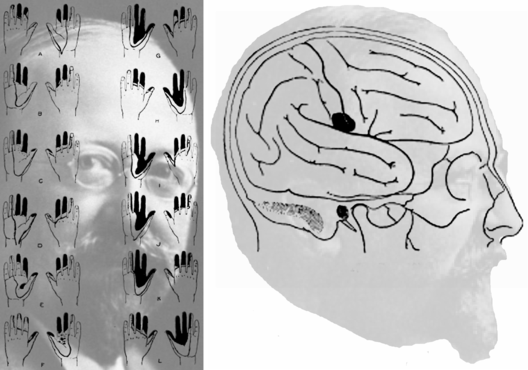Henry Head1861–1940
Head based his physiology of the nervous system on clinical observations. His particular interest was in linking sensation to localization and this he examined with regard to the peripheral nerves. Head’s head is shown on the left in a diagram of hands in which the black areas indicate loss of sensation due to division of the median nerve; each pair of hands represents a different case. He also studied head injuries of soldiers in World War I, and he can be seen on the right within his illustration of a right parietal bullet wound. This case was of particular significance because the patient displayed sensory loss of the tactile hairs over the thumb, index and middle fingers, “although the power of appreciating passive movement and vibration was perfectly preserved”. When considering the theoretical significance of his studies, head introduced a concept that was to have wider appeal in psychology than in medicine. The concept was of ‘schema’ and it was applied to the control of posture. He wrote: “For this combined standard, against which all subsequent changes of posture are measured before they enter consciousness, we propose the word ‘schema’. By means of perpetual alterations in position we are always building up a postural model of ourselves which constantly changes. Every new posture of movement is recorded on this plastic schema and the activity of the cortex brings every fresh group of sensations evoked by altered posture into relation with it. Immediate postural recognition follows as soon as the recognition is complete”. He mentioned the case of a patient who had lost a leg and reported phantom limb sensations until a cerebral lesion removed sensation from the remaining parts of his leg as well as the phantom. “It is to the existence of these ‘schemata’ that we owe the power of projecting our recognition of posture, movement and locality beyond the limits of our bodies to the end of some instrument held in the hand.” Bartlett extended the concept of schema into the cognitive domain, proposing that we make mental models of the environment in which we behave. Head concluded the second volume of his Studies of Neurology (1920) with reflections on studies of the nervous system over the previous decades. His view was: “The functions of the central nervous system are not a palimpsest, where new text is written over an earlier manuscript, partly erased. The more primitive activities have been profoundly modified by the advent of the new centres, which utilise some of the faculties originally possessed by the older mechanism. In many cases the higher function could be excised, without the existence of these lower powers which it dominates and controls.”
